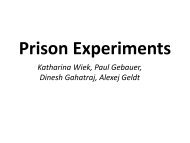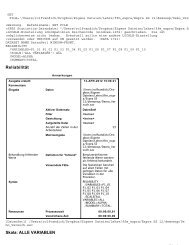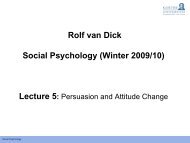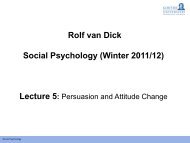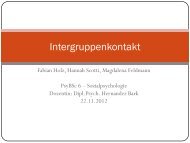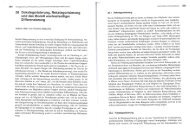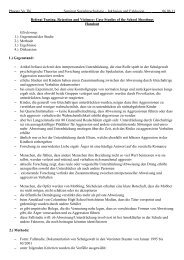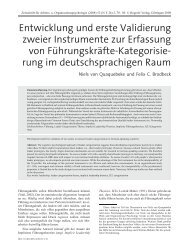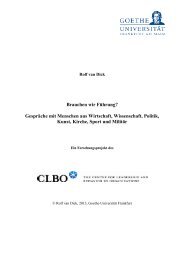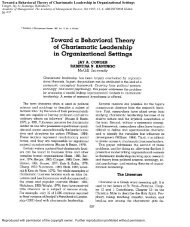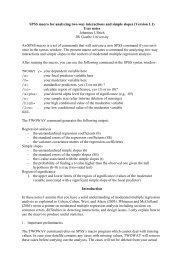Social Identity Theory and Self-categorization Theory: A Historical ...
Social Identity Theory and Self-categorization Theory: A Historical ...
Social Identity Theory and Self-categorization Theory: A Historical ...
Create successful ePaper yourself
Turn your PDF publications into a flip-book with our unique Google optimized e-Paper software.
<strong>Social</strong> <strong>Identity</strong> <strong>Theory</strong> <strong>and</strong> <strong>Self</strong>-<strong>categorization</strong> <strong>Theory</strong> 211<br />
members (Turner, 1991). Public compliance does exist in this formulation,<br />
but primarily as a response to the norms <strong>and</strong> power of outgroups.<br />
From this perspective, people are influential within groups to the extent<br />
that they embody the prototypical attitudes, behaviours, <strong>and</strong> values of the<br />
group. Leaders manage their rhetoric to locate themselves within the<br />
heart of the group (Reicher & Hopkins, 1996), <strong>and</strong> to the extent that<br />
they succeed in doing this, leaders will be seen to be more legitimate <strong>and</strong><br />
more influential (Hogg, 2001; Hogg, Hains, & Mason, 1998). Indeed,<br />
Turner (2005) sees the <strong>categorization</strong> process as the causal driver of power<br />
<strong>and</strong> influence. From this perspective, embodying the prototype of the<br />
ingroup is what maximizes influence, influence is the basis of power, <strong>and</strong><br />
power leads to control over resources. This is a reversal of the traditional<br />
approach to power, which suggests that control over valuable resources is<br />
what defines power, power allows for influence, <strong>and</strong> mutual influence<br />
leads to the formation of psychological groups.<br />
Empirical Research within the <strong>Social</strong> <strong>Identity</strong> Approach<br />
In the 1970s, much of the empirical work surrounding the social identity<br />
approach involved establishing the results of the minimal group paradigm<br />
<strong>and</strong> then defending the interpretation of the results from alternative<br />
explanations. This was seen to be important because the results of the<br />
minimal group paradigm were the lever which distinguished the social<br />
identity approach from its main rivals (especially realistic conflict theory;<br />
Sherif, 1966). Because of the minimal nature of the groups, it is not possible<br />
to explain this behavior in terms of relative deprivation, frustration, or<br />
competition for limited resources. Various other explanations were raised<br />
<strong>and</strong> dismantled. Ingroup bias did not appear to be a result of the<br />
uncertainty of the experimental procedure (Tajfel & Billig, 1974), nor was<br />
it a by-product of the fact that group members assumed high levels of<br />
interpersonal similarity with each other (Billig & Tajfel, 1973). Suspicions<br />
that the results are an artifact of dem<strong>and</strong> characteristics <strong>and</strong> experimenter<br />
effects appear to have been laid to rest (St Claire & Turner, 1982; Tajfel<br />
& Turner, 1979). Post-experimental enquiries tend to find that participants<br />
are unaware of the hypotheses, <strong>and</strong> behaviour does not substantially change<br />
even when the hypotheses are presented to them.<br />
A sterner challenge to the social identity interpretation of the minimal<br />
group paradigm came from Rabbie <strong>and</strong> colleagues, who argued that<br />
participants in minimal groups infer interdependence between their points<br />
allocations <strong>and</strong> the points they would receive from others. Thus, ingroup<br />
bias in allocations occurs because participants expect that the outgroup<br />
will discriminate against them, <strong>and</strong>/or because they think that it will<br />
enhance the benefits that they receive from other ingroup members. Evidence<br />
for this was inconsistent: Diehl (1990) found that the pattern of ingroup<br />
bias occurs even when participants are told that the outgroup is treating<br />
© 2008 The Author <strong>Social</strong> <strong>and</strong> Personality Psychology Compass 2/1 (2008): 204–222, 10.1111/j.1751-9004.2007.00066.x<br />
Journal Compilation © 2008 Blackwell Publishing Ltd



